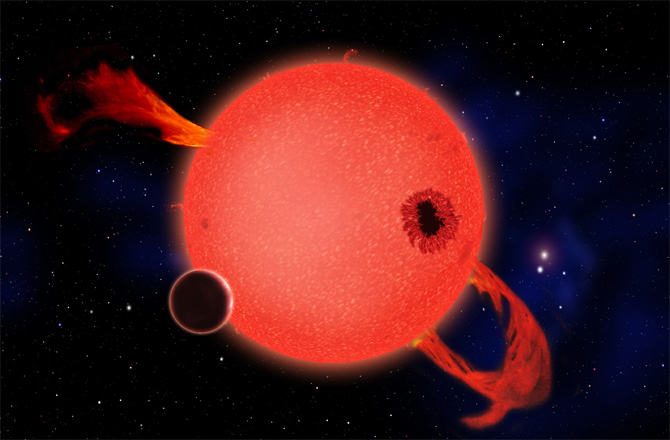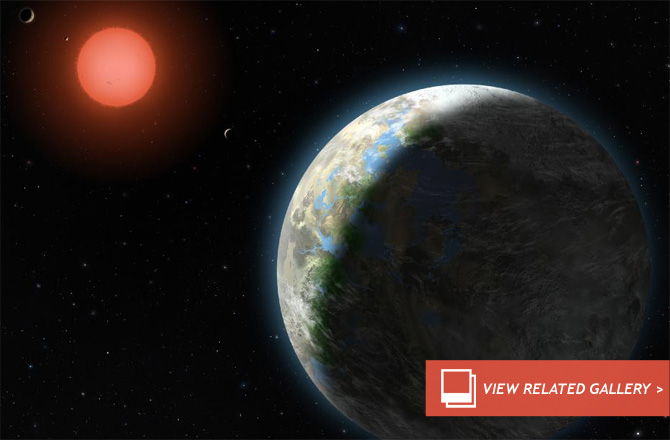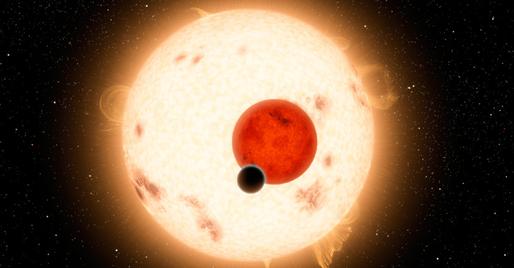It looks like you're using an Ad Blocker.
Please white-list or disable AboveTopSecret.com in your ad-blocking tool.
Thank you.
Some features of ATS will be disabled while you continue to use an ad-blocker.
3
share:
That is mind blowing!! "Every Red Dwarf Hosts at Least One Exoplanet", and from what I remember hearing, around 3 quarters, 3/4 of all stars are Red
Dwarf's!! (let me check that real fast lol!!)
haha! I was right!! Just looked it up below.. (heard that on some show last week and can't remember the show lol!! Just the 3/4 mentioned..
Anyway...that is a lot of planets!! Life as we know it is out there. No doubt in my mind what so ever!! Is there one person out there that doesn't (hate to say believe that) think so ????
Artist's impression of a small rocky world orbiting a flaring red dwarf star.

Something to ponder.

That's why I know there's some kind of life out there. The odds are so great as to just not even think any other way!!
Exquisite Exoplanetary Art: Photos

Go here for more!! Pictures : news.discovery.com...
source: news.discovery.com...
haha! I was right!! Just looked it up below.. (heard that on some show last week and can't remember the show lol!! Just the 3/4 mentioned..
Red dwarfs are by far the most common type of star in the Milky Way galaxy, at least in the neighborhood of the Sun, but due to their low luminosity, individual red dwarfs cannot easily be observed. From Earth, not one is visible to the naked eye.[1] Proxima Centauri, the nearest star to the Sun, is a red dwarf (Type M5, apparent magnitude 11.05), as are twenty of the next thirty nearest. According to some estimates, red dwarfs make up three-quarters of the stars in our galaxy.[2] en.wikipedia.org...
Anyway...that is a lot of planets!! Life as we know it is out there. No doubt in my mind what so ever!! Is there one person out there that doesn't (hate to say believe that) think so ????
Artist's impression of a small rocky world orbiting a flaring red dwarf star.

Red dwarf stars may be small, but they could be critical in the continuing hunt for exoplanets and the possibility of finding habitable alien worlds. In a new study, an international team of astronomers have estimated that every red dwarf in our galaxy hosts at least one exoplanet and that one quarter host super-Earths orbiting within their habitable zones.
Something to ponder.
ANALYSIS: Smartest Aliens May Live Around Red Dwarf Stars
source: news.discovery.com...
The scientists say the best place buy real estate for long-term habitability is around a red dwarf star. A planet can remain cozy for advanced life for a stretch of time that is five times greater than for Earth. All other thing being equal, this suggests that SETI searches should target red dwarfs to see if they are home to advanced civilizations that do not have to worry about the clock running out.

That's why I know there's some kind of life out there. The odds are so great as to just not even think any other way!!
Exquisite Exoplanetary Art: Photos

Go here for more!! Pictures : news.discovery.com...
source: news.discovery.com...
We're a grain of sand on the oceans of the universe, yet some would think we're all alone, whereas in truth, life is abundant.
Our Mathematical Universe: My Quest for the Ultimate Nature of Reality. Maxreply to
post by Unity_99
This is a good read for the brain on our (and other) Universe : Source www.academia.edu...
below part of article from above source;
(Quote) " It‘s as if the universe repeatedly
splits in two, resulting in innumerable copies of you in parallel worlds. As a bonus, the
randomness of the universe that so troubled Einstein disappears, being simply ―how it
feels
when you‘re cloned‖. Tegmark calls these parallel worlds Level III universes that together
make up the Level III multiverse. He plays with the consequences of this mind-splitting picture of multiple realities, exploring such topics as quantum suicide and the possibility of
quantum immortality and demonstrating why your brain and its consciousness can‘t be a
quantum computer." (end quote)
Wow!!
This is a good read for the brain on our (and other) Universe : Source www.academia.edu...
below part of article from above source;
(Quote) " It‘s as if the universe repeatedly
splits in two, resulting in innumerable copies of you in parallel worlds. As a bonus, the
randomness of the universe that so troubled Einstein disappears, being simply ―how it
feels
when you‘re cloned‖. Tegmark calls these parallel worlds Level III universes that together
make up the Level III multiverse. He plays with the consequences of this mind-splitting picture of multiple realities, exploring such topics as quantum suicide and the possibility of
quantum immortality and demonstrating why your brain and its consciousness can‘t be a
quantum computer." (end quote)
Wow!!
Title of the thread made me think of Red Dwarf Tv series
It is really humbling when you look up at the night sky..
It is really humbling when you look up at the night sky..
Like most people I expect there is extraterrestrial life but am not as certain about whether it's intelligent because lets face it; even on Earth intelligent life has been absent for 99.999% of Earth's history, so by that measure it's extraordinarily rare even here.
RUFFREADY
Anyway...that is a lot of planets!! Life as we know it is out there. No doubt in my mind what so ever!! Is there one person out there that doesn't (hate to say believe that) think so ????
We think we have a chance of finding life elsewhere in our solar system, like maybe underground on Mars or perhaps underwater in Jupiter moons containing water, but I don't think any scientists expect it to be intelligent.
It's not apparent that intelligence is an inevitable consequence of evolution. There is also the Fermi Paradox.
However you may have overlooked something about red dwarf stars which may make them not so conducive to life as we know it (The OP even pictures a violent red dwarf flare, but you may have overlooked the significance of it relating to exobiology):
Drake Equation
most stars in our galaxy are red dwarfs, which flare violently, mostly in X-rays, a property not conducive to life as we know it. Simulations also suggest that these bursts erode planetary atmosphere.
Artist's impression of a small rocky world orbiting a flaring red dwarf star.
So with an eroded atmosphere and blasted with violent x-ray flares, don't get your hopes up too much on planets orbiting such stars. There might be exceptions.
edit on 8-3-2014 by Arbitrageur because: clarification
Unity_99
We're a grain of sand on the oceans of the universe, yet some would think we're all alone, whereas in truth, life is abundant.
So few people believe we are all alone in the universe that I really wouldn't worry about it; there will always be a certain number of exceptions.
Practically all people with a basic enough education as to be able to understand the size of the universe also understand that there is almost surely life elsewhere. That's why I think it's a bit of a strawman argument to say "some people think we are alone". Those "some people" are very few and very far between among people with even a basic education
new topics
-
How Long have You been Alive?
Other Current Events: 2 hours ago
top topics
-
Congress 2024 - We do not want me in our ladies rooms
US Political Madness: 13 hours ago, 9 flags -
My Pet Elephant For A Day…
Short Stories: 13 hours ago, 6 flags -
How Long have You been Alive?
Other Current Events: 2 hours ago, 4 flags -
A call to repentance—God is patient, but His patience does not abide forever.
Religion, Faith, And Theology: 13 hours ago, 3 flags
3
